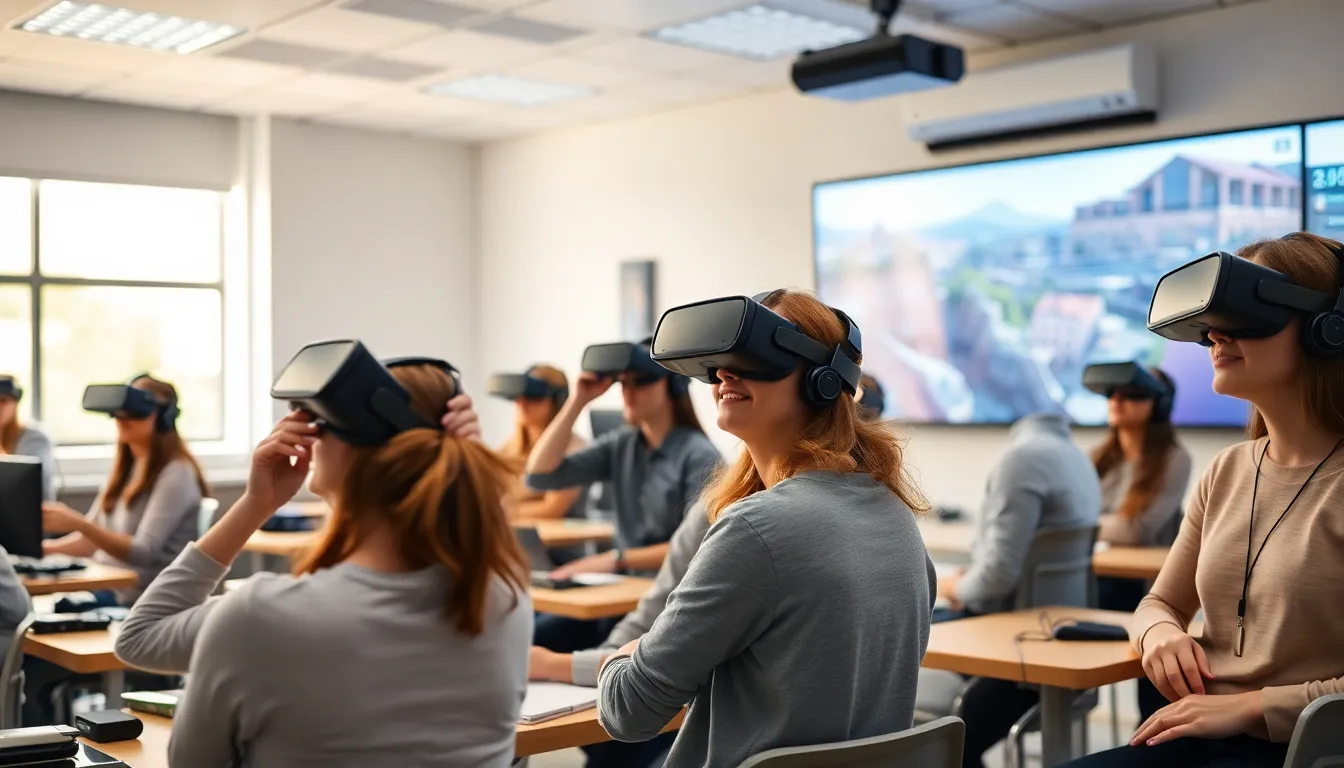The virtual reality (VR) industry is experiencing an unprecedented surge, reshaping how people interact with technology and each other. As advancements in hardware and software continue to evolve, VR is no longer confined to gaming; it’s making waves in education, healthcare, and even real estate. This rapid growth presents exciting opportunities for businesses and consumers alike.
With a projected market value reaching billions in the coming years, the demand for immersive experiences is skyrocketing. Companies are investing heavily in VR solutions, aiming to enhance user engagement and create innovative applications. As the landscape transforms, understanding the driving forces behind this growth becomes essential for anyone looking to navigate the future of technology.
Table of Contents
ToggleOverview of the VR Industry
The VR industry demonstrates remarkable growth, with a market value exceeding $15 billion in 2022. Projections estimate this figure to surpass $57 billion by 2027, reflecting a compound annual growth rate (CAGR) of over 27%.
The integration of VR technology across various sectors drives this expansion.
- Gaming: The gaming segment constitutes a significant portion of the VR market, capturing approximately 45% of total revenues. Popular platforms like Oculus and PlayStation VR enhance user experiences through immersive gameplay.
- Education: Educational institutions increasingly adopt VR for interactive learning. Immersive simulations allow students to engage with complex subjects, making abstractions tangible.
- Healthcare: The healthcare sector leverages VR for training and therapy. Surgeons utilize simulations for skill development, while patients undergo VR therapy for phobias and pain management.
- Real Estate: Real estate markets employ VR for virtual property tours, empowering potential buyers to explore homes remotely, thus enhancing the selling process.
The demand for immersive experiences fuels investment from major technology firms. Companies like Facebook (Meta), Google, and Microsoft pour resources into developing VR ecosystems and applications, recognizing the technology’s potential to transform user interaction. Innovations in hardware and software continue to emerge, further pushing the industry forward.
Understanding the driving forces behind this growth proves essential for stakeholders aiming to navigate the evolving landscape of the VR industry.
Factors Driving VR Industry Growth

Several key factors contribute to the rapid growth of the VR industry, impacting various sectors and leading to substantial market expansion.
Technological Advancements
Technological advancements play a crucial role in enhancing the VR experience. Innovations in hardware, such as lighter and more powerful headsets, improve comfort and usability. Graphics capabilities continue to evolve, providing hyper-realistic visuals that enhance immersion. Developments in software, including improved tracking systems and user interfaces, enhance user interaction. Such technological progress encourages wider adoption, as developers create more compelling content that meets consumer expectations.
Increased Adoption Across Sectors
Increased adoption across multiple sectors drives VR industry growth significantly. The education sector harnesses VR for interactive learning experiences, enabling students to engage with complex topics in immersive environments. The healthcare industry benefits from VR applications in training medical professionals and providing therapeutic experiences for patients. Real estate agents utilize VR for virtual property tours, allowing prospective buyers to explore homes remotely. Businesses in retail and tourism also leverage VR for immersive marketing strategies and virtual experiences, expanding the market’s reach. This diverse adoption creates multiple revenue streams and fosters continued investment, further propelling the industry’s expansion.
Key Market Trends
The VR industry is experiencing notable trends that highlight growing consumer interest and increased enterprise applications. These trends signal a broader acceptance of VR technology across various demographics and sectors.
Consumer Interest and Acceptance
Consumer interest in VR technology continues to rise, with approximately 70% of consumers expressing a willingness to use VR in everyday activities. Smartphone integration and the availability of affordable headsets contribute to this acceptance. Major gaming platforms boost engagement by offering exclusive VR titles, improving access to immersive content. Additionally, social VR platforms are gaining traction, allowing users to connect and interact in virtual spaces. These developments foster community engagement and enhance the overall user experience.
Enterprise Solutions and Applications
Enterprise adoption of VR is accelerating rapidly, with over 45% of organizations implementing VR solutions in training and simulations. Industries such as healthcare leverage VR for surgical training and patient therapy, enhancing educational outcomes and treatment effectiveness. In real estate, agents utilize VR for remote property tours, improving the buyer’s experience. Manufacturing companies implement VR for design visualization and safety training, reducing costs and increasing efficiency. These diversified applications created a robust market for enterprise VR solutions, encouraging further investment and innovation.
Challenges to VR Industry Growth
Despite significant growth, the VR industry faces several challenges that could hinder its expansion. Key issues include high costs, accessibility, and content creation hurdles.
High Costs and Accessibility
High costs remain a central barrier to VR adoption. Premium headsets can exceed $1,000, limiting consumer access. Additionally, robust hardware is often necessary for optimal experiences, further increasing expenses. It’s estimated that only 25% of U.S. households can afford even basic VR setups. Accessibility isn’t solely about price; technical literacy also plays a role. Many potential users struggle with setup and navigation, which discourages broader adoption. Addressing these financial and technical accessibility challenges is critical for fostering a larger user base.
Content Creation and Development
Content creation poses another significant obstacle for the VR industry. Developers face high production costs associated with creating immersive experiences. For instance, producing a high-quality VR game can range from $500,000 to several million dollars, which limits the number of available titles. Furthermore, a shortage of skilled developers in VR technologies complicates the situation, as traditional game development skills don’t always translate seamlessly to VR. It’s estimated that less than 10% of existing video games incorporate VR elements, indicating a need for more diverse content. Enhancing the content offering through collaboration and training will be vital for maintaining consumer interest and fostering industry growth.
Future Outlook for the VR Industry
The VR industry is set to experience continued growth through innovation and expanded applications. Market forecasts predict sustained interest as revenues are expected to surpass $57 billion by 2027, fueled by a CAGR of over 27%. Increased funding from major tech firms underscores this momentum, as companies invest heavily in VR hardware, software, and infrastructure.
Technological advancements will play a crucial role in enhancing user experiences. Newer models of headsets will feature improved comfort, reduced weight, and higher resolution displays, making VR more accessible. Emerging trends include wireless features and cross-platform compatibility, which will further attract users. Seamless integration with smartphones and tablets is also anticipated to drive mass consumer adoption.
Educational institutions will increasingly incorporate VR into curricula, enhancing interactive learning experiences. For instance, simulations that allow students to conduct virtual experiments or explore historical sites will become more common. This trend extends to corporate training, where immersive simulations will promote effective skill development and onboarding processes.
In healthcare, VR applications will expand. Facilities may utilize VR for patient treatment, pain management, and rehabilitation exercises. For example, therapeutic VR experiences can help patients cope with anxiety or phobias, demonstrating measurable improvement in patient outcomes.
Real estate firms will continue leveraging VR technology for virtual property tours, allowing prospective buyers to explore listings remotely. Increased accessibility to VR tools will support agents in closing deals more efficiently, capturing the attention of tech-savvy clients.
Enterprise adoption will persist, with over 45% of organizations already using VR for training and simulations. Industries like manufacturing, retail, and tourism may follow suit, recognizing the cost-effective benefits of VR applications. Enhanced customer engagement through VR experiences will create additional revenue opportunities.
Despite growth prospects, the VR industry must overcome challenges. High production costs for premium headsets can stifle market penetration. Overcoming technical barriers, such as user navigation issues, is vital for expanding the user base. Inadequate content creation and a shortage of professionals will also need addressing to ensure diverse offerings in VR experiences.
Investment in skill development for creators will be critical. Providing incentives for developers and improving accessibility to affordable content creation tools can boost supply in the VR market. In doing so, the industry may attract a broader audience and stimulate sustained engagement with virtual reality technologies.
The VR industry stands on the brink of transformative growth as it continues to penetrate various sectors. With projections indicating a market value exceeding $57 billion by 2027, the momentum shows no signs of slowing down. Key players are investing heavily in technology that enhances user experience and accessibility.
However, challenges like high costs and technical literacy must be addressed to unlock the full potential of virtual reality. By focusing on affordable solutions and content creation, the industry can expand its reach and foster a more inclusive user base. As VR becomes increasingly integrated into daily life, its impact on education, healthcare, and beyond will redefine how individuals and businesses interact with technology.


